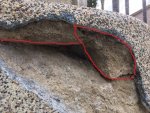I took the plunge, not in a bad way. I've been wanting to contribute but just have not had the money. I still didn't but just could not feel good about utilizing the awesome resource TFP without contributing. Glad to be a silver supporter with plans to upgrade to Gold. This forum has provided me with so much guidance, help and direction.
I am in process of rehabilitating our pool. It all started with "just" the flagstone coping needing to be redone which is a large enough project , then added the removal of the top 3.5" of pebble tec due to delamination, damage and old repairs not matching, this is still in process (separate thread).
Now.... to the last issue (I hope) Seat Repair...How?
I knew I had some delaminated pebble tec on our seat, but today I decided to remove just a small piece and to my surprise the gunite below the pebble tec has some integrity issues.
1. First pic (Seat1) - The seat and the outline indicates the pebble tec I will need to remove
2. Second pic (Seat2) - you can see a chunk of the gunite that came out with the pebble tec. Red circle shows what also might be loose
3. Third pic (Seat3) - shows most likely the part of the seat I will need to rebuild
My initial thought is I will need to create a form and then use cement to rebuild the seat. How exactly? What kind of cement, and materials do I use? Any tips / help you have to offer is greatly appreciated.
I am in process of rehabilitating our pool. It all started with "just" the flagstone coping needing to be redone which is a large enough project , then added the removal of the top 3.5" of pebble tec due to delamination, damage and old repairs not matching, this is still in process (separate thread).
Now.... to the last issue (I hope) Seat Repair...How?
I knew I had some delaminated pebble tec on our seat, but today I decided to remove just a small piece and to my surprise the gunite below the pebble tec has some integrity issues.
1. First pic (Seat1) - The seat and the outline indicates the pebble tec I will need to remove
2. Second pic (Seat2) - you can see a chunk of the gunite that came out with the pebble tec. Red circle shows what also might be loose
3. Third pic (Seat3) - shows most likely the part of the seat I will need to rebuild
My initial thought is I will need to create a form and then use cement to rebuild the seat. How exactly? What kind of cement, and materials do I use? Any tips / help you have to offer is greatly appreciated.





